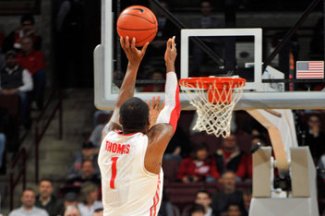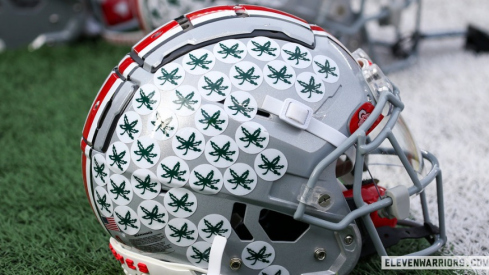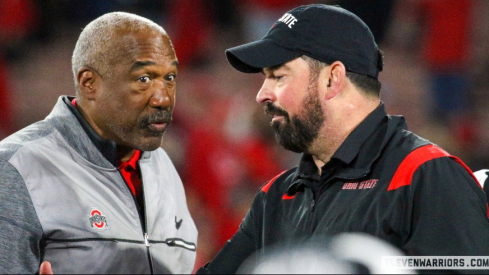
Another day, another episode of the NCAA's ongoing clown show.
The latest segment came via President Mark Emmert's lips as he announced NCAA investigators had improperly obtained information as part of its investigation into the shenanigans allegedly going on within the Miami Hurricane football and basketball programs.
You've probably heard about it. It's the one where Nevin Shapiro, the mastermind of a gazillion dollar Ponzi scheme, was allegedly treating players to parties at strip clubs, his mansion, and on yachts, paying for the abortion of a player-impregnated stripper while supplying everything from cash to jewelry to prostitutes to plasma TVs to Heat tickets.
Yesterday, Emmert announced the NCAA has halted the investigation due to the information-collection impropriety in which NCAA investigators hired Nevin Shapiro's defense attorney to share information useful to their case obtained through depositions associated with Shapiro's bankruptcy, even though those proceedings had nothing to do with the NCAA's investigation.
As a result, Emmert has hired outside counsel, seeking their assistance in determining what information was collected legitimately and what information will be thrown out. Once that process is complete, the NCAA will then move forward in hopes of finally delivering an official Notice of Allegations to the university.
Of particular note is said to be information obtained improperly regarding Sean Allen, a former 'Cane equipment-room staffer who also moonlighted as an employee of Shapiro's recently formed sports agency. Some have already asserted throwing out information uncovered during the Allen deposition could be a big win for the Hurricanes but Emmert did try to put some duct tape on the situation:
Emmert said any evidence that is tossed out will not be revisited by investigators, but he stressed that only “small portions” of evidence were collected improperly.
“We’ll use the information that was collected appropriately,” he said. “My understanding is there is a great amount of evidence that has been compiled in this case.”
Added Emmert: “One of the questions that has to be answered is: What was the nature of that contractual arrangement [between our investigators and Perez]? What was all the activity that she was involved with? How did this individual engage in these activities on our behalf?” Asked if this could be viewed as a mistrial of sorts and work in Miami’s favor, Emmert said: “It’s premature to answer that question... This is a shocking affair.”
While it remains to be seen how this development helps the Hurricanes, there's no question it's another huge shiner for an organization that has taken more beatings than Glass Joe. And here's Dan Wetzel with his usual knockout blow.
![]() DUCK AND COVER. In the wake of Phlip Kelly leaving the Ducks for a shot at the highest level with the Eagles, potentially in part due to the NCAA's investigation into the football program's relationship with street agent Willie Lyles, the Oregon administration made an effort to show the NCAA just how gosh darn serious they are about compliance.
DUCK AND COVER. In the wake of Phlip Kelly leaving the Ducks for a shot at the highest level with the Eagles, potentially in part due to the NCAA's investigation into the football program's relationship with street agent Willie Lyles, the Oregon administration made an effort to show the NCAA just how gosh darn serious they are about compliance.
Oregon's offensive coordinator, Mark Helfrich, was officially hired to replace Kelly as head coach and his five-year contract contains some interesting verbiage in an exhibit detailing what is expected:
The deal also has a lengthy exhibit laying out a 10-point set of responsibilities that Helfrich has in monitoring rules compliance and the terms of annual communication required to occur between Helfrich, the university president, the athletics director and the compliance director.
Obviously, all head coaching contracts have general verbiage about compliance but none of Kelly's three contracts with Oregon had any additional non-standard clauses and the ones included in Helfrich's deal are considered to be "extraordinary in scope and detail". A sampling:
- Create written procedures "to ensure that the football staff, including assistant coaches, is monitoring the football program's rules compliance."
- Assign football staff members to "monitor specific areas of compliance (e.g. recruiting contacts, initial eligibility, amateurism, telephone contacts)."
- Regularly evaluate football staff members "to ensure their areas of compliance are monitored and that all responsibilities are executed in a timely manner."
- Determine reporting lines to alert compliance staff of "issues involving prospective student-athletes and current student-athletes."
- Ensure that the football staff "immediately notifies the compliance staff when concerns or red flags occur related to potential NCAA rules violations."
I can't be the only one scratching my head at how these stipulations could be considered so "extraordinary" in nature. Most of it is nothing but wordy bullets that are obvious things most head coaches would be asked to manage. Knowing the NCAA, they'll somehow find this impressive.
![]() FIRST WORLD PROBLEM. I typically shy away from Dennis Dodd's work because we can't take a guy that rocks Tommy Bahama shirts – basically Affliction for middle-aged men – seriously, and things like this, but he put out an interesting piece pondering whether or not technological and financial change had caused the business of college football to peak.
FIRST WORLD PROBLEM. I typically shy away from Dennis Dodd's work because we can't take a guy that rocks Tommy Bahama shirts – basically Affliction for middle-aged men – seriously, and things like this, but he put out an interesting piece pondering whether or not technological and financial change had caused the business of college football to peak.
One angle looked at how the advent of smartphones and affordable big-screen HD televisions has fans staying at home to watch games in comfort with an improved viewing experience. Michigan State's AD, Mark Hollis, notes that particular problem could have a wave effect. Considering many of those skipping games are gadget-savvy students and young people who will have opted to pass on attending games before the schools could get 5-10 years of ticket revenue from them, Hollis probably has a right to be concerned.
At the same time, even with the knowledge this past year's overall regular season ratings slid almost across the board (ESPN -4%, ESPN2 -13%, CBS -10%), there are still what seems like a couple hundred games televised on the average fall Saturday and the coverage is only expanding. Leagues already have, or soon will have, their own networks, ESPN is wielding its power and FOX is launching a new channel with heavy emphasis on college football.
With a playoff still on the horizon, while there could be some empty seats along the way, I have a hard time believing that college football, or the business surrounding it, will be peaking any time soon.
 Deshaun showing the sweet stroke
Deshaun showing the sweet stroke![]() ONE SHINING MOMENT. The B1G has some outstanding individual players this year and Tom Dienhart of the BTN took a stab at naming the seven players, in order, that he'd want taking the last shot.
ONE SHINING MOMENT. The B1G has some outstanding individual players this year and Tom Dienhart of the BTN took a stab at naming the seven players, in order, that he'd want taking the last shot.
Dienhart has Deshaun Thomas at the top his list:
The guy is the best pure scorer in the Big Ten with seemingly limitless range—witness a league-high 20.5-scoring average. And check out his 41.9 shooting percentage from three-point range. Plus, the 6-7 junior brims with confidence and is fearless with the ball in his hands, able to shoot over foes or drive by them.
The rest of his list included Trey Burke, Brandon Paul, Jordan Hulls, Andre Hollins, Tim Hardaway Jr and DJ Byrd.
At the time of this writing, the "Other" category was running away with the voting but looking at the player-specific votes, Burke (9.9%) was edging out Deshaun's 9.56%.
I guess a case could be made for Christian Watford because of his clutch three to beat Kentucky last year but I think Dienhart's order would be similar to mine. I'd go Deshaun and Burke as my top two but after that, I'd probably take Hulls or Keith Appling. I'd throw Brandon Paul in the mix but I'm still not over Ohio State letting him get off for 43 last year. I'd rather run a last second pick and pop with Scott and Amir.
How would you rank 'em?
![]() SIGN OF THE TIMES. The always solid Bruce Feldman examined the list of early NFL entrants to determine which schools will be hit hardest as their underclassmen make their bid for a pro contract.
SIGN OF THE TIMES. The always solid Bruce Feldman examined the list of early NFL entrants to determine which schools will be hit hardest as their underclassmen make their bid for a pro contract.
To the surprise of no one, Feldman placed six SEC programs in the top ten, including the top five spots overall.
LSU tops the list with a ridiculous 11 early entrants, and five of those players are projected to be selected in the first two rounds of the draft. On the defensive side of the ball, LSU loses 388 tackles, 43 TFLs and 16.5 sacks, making them the runaway choice for the top spot.
Tennessee ranks 2nd thanks to losing a pair of big wideouts, a defensive lineman and Tyler Bray with Florida 3rd after losing Shariff Floyd and safety Matt Elam. Poor Alabama only ranks 7th despite losing their bone-crushing running back in Eddie Lacy, a stud tackle in D.J. Fluker and an elite corner in Dee Milliner.
Only one B1G team made the list with Michigan State checking in at #9 following the early departures of Le'Veon Bell, William Gholston, and Dion Sims. I think you could make a case for ranking Sparty much higher, figuring it's significantly harder for Dantonio to replace guys compared to his medical hardship, oversigning counterparts in the South.
![]() ALL KINDS OF TOTALLY RAD STUFF. 'The Chronic' 20 Years Later... Jordan Hicks and Case McCoy will not be charged... Some of the lesser candidates that applied for Bielema's former job... Rodney Williams is a student of the Cardale Jones School of Twitter... Seven potential new careers for Ray Lewis to consider... Reviewing Super Bowl starters as college recruits... Lattimore is one bad dude... Drug War in Mexico: 2007 vs. 2011... Kobe live tweeted yesterday's shoot-around.
ALL KINDS OF TOTALLY RAD STUFF. 'The Chronic' 20 Years Later... Jordan Hicks and Case McCoy will not be charged... Some of the lesser candidates that applied for Bielema's former job... Rodney Williams is a student of the Cardale Jones School of Twitter... Seven potential new careers for Ray Lewis to consider... Reviewing Super Bowl starters as college recruits... Lattimore is one bad dude... Drug War in Mexico: 2007 vs. 2011... Kobe live tweeted yesterday's shoot-around.

